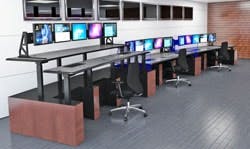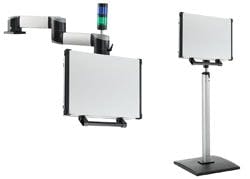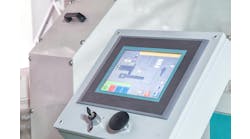Our multi-machine workstations haven't changed much beyond the sophistication of the HMI software and better tactile input methods. The operators now spend more time at the workstation and less time patrolling the machines with clipboards since we have much more operational data feedback at the HMI. We need an ergonomic tune-up to make sure the operators are safely paying attention to the increased amount of operating data without being too comfortable to be attentive. Any experiences to share?
—From September 2014 Control Design
ANSWERS
Mixed Technologies
This can be best accomplished by employing a mixed-technologies approach along with ergonomic design principles when creating an optimal user interface.
By utilizing and implementing a design which incorporates all forms of human-machine interface (HMI), a complete and consolidated user experience can be accomplished. HMI systems have to be designed with the user and application environment in mind. You first have to define the operational and functional requirements. This can encompass durability requirements and environmental stresses including exposure to moisture, vandalism, temperature extremes, cleaning agents and general rough use. Operator feedback is critical to capture end-user attention and to ensure overall effectiveness and efficiency. Understanding the application can dictate the degree of HMI complexity. And regulatory standards must be considered to meet industry criteria.
Also read: Versatile HMIs Combine Functions
All of these aspects influence the design of the interface in order to capture user attention and to ensure safe operation. This is why a mixed-technologies approach is best. Not one single technology has the ability to provide an all-encompassing solution. Once the application and user requirements are defined, a mixture of pushbuttons, cursor controls, keyboards, touch technologies and interactive displays can interface with industrial computers to inform, alert and efficiently update the user of machinery functions. Use of illumination techniques such as ring, Halo or animation combined with audible alerts capture end user attention in both an aesthetically pleasing, modern appearance and forthrightly effective manner. The mixing and matching of components and technologies allow for a consolidated user interface along with a central and sometimes singular point of data feedback.
Dan DiGioa
marketing manager,
EAO
Brent Leimer
marketing manager,
Winsted
Emily Delozier,
global product manager for large and HMI enclosure systems,
Pentair
Operator Ergonomics
HMIs are available as free-standing operator stations, console stations or pedestal or support arm systems. Depending on the application and available floor space, appropriate solutions can be selected. Systems are available in aluminum, mild steel and stainless steel to address differing application, environment and aesthetic requirements.
Many users are transitioning to the support arm with enclosure solution as it can be safely moved in and out of the workplace when programming or data acquisition has been completed. Support arm systems provide options for vertical motion, swinging motion and swiveling to move the HMI enclosure into the most ergonomic position for the operator to access. Considerations for operator ergonomic use, safety, floor space, environmental performance, weight load, heat management, aesthetics and cost should all be considered when selecting the correct HMI solution.
Greg Quick,
product manager,
wallmounts and HMI,
Rittal
The following responses to the question were posted on LinkedIn.
Data Flood
An interesting quandary you envision. Most processes I have worked with still involve regular operator interaction to load parts and/or renewable supplies and provide regular quality checks, some as often as every 10 or 15 minutes, so I think that we have freed up the operator to focus on the process and the product, rather than boring him so much that he becomes inattentive. As interface designers, we gather and present more and more data, and our challenge is to crunch the data and present it as simplified choices the operator can make quickly, rather than flooding his screen with distracting raw data and expecting him to analyze it. My goal is to always reduce the amount of data and choices and operations in any given sequence an operator will have to make. For every decision or step of manual workflow that you can remove for an operator, you exponentially reduce the possible outcomes and effectively reduce risk by the same factor.
Steve Meredith,
reliability electrical coordinator,
Corod Division at Weatherford
Poka-Yoke
[pullquote]In the process of making our systems fully automated, we're making operators less attentive and less prepared to handle problems. There is a tendency to put so much information on the operator screens that they can't see the things that are really important. I advocate systems like poka-yoke that reduce chances of mistakes, rather than making operators passive.
Chua KM,
director,
Bistanika Sdn Bhd
Operator Evolution
It sounds like the right direction—machine data processing evolution—but operator evolution may be a concern. As more data is collected, the machine should process more data, so the operator has to process less data. The direction of less human dependency in the process equals less human error and risk, and greater safety, reliability and repeatability. But at the same time, operator evolution must take place to guide the operator to perform new tasks with their new time that was freed up by machine evolution.
Excitingly and interestingly, machine data collection will eventually evolve to collecting data about the human operators, too, so as to further reduce human error and increase safety. The human motion/gesture sensing on games such as Xbox will be incorporated; later, even health vitals and retina scans will be incorporated. So the machine may sound an alarm if my human operator has fallen asleep, is drunk, is sick or is in the wrong place at the wrong time, that is, for the few machines in that distant future that still require a human to operate them.
Don Fitchett,
president,
Business Industrial Network
Autonomy
I also believe automation today is and should move toward autonomous automation, where whole facilities can be run from a central SCADA position with multiple monitors observing multiple machines and maybe even multiple facility locations, simultaneously.
Monty Bass,
engineering & maintenance manager,
Exide Technologies






